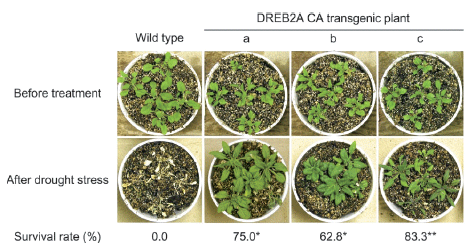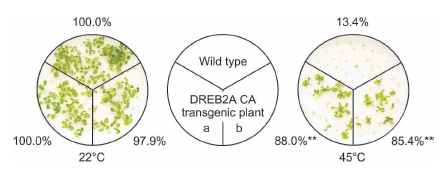Improving plant drought stress tolerance by utilizing an engineered DREB2A gene that encodes an activated transcription factor
Description
There are concerns that intensification of global warming will give rise to environmental pollution and abnormal weather. Breeding of stress-tolerant plants is thus an important solution for both agricultural and environmental issues. In this study, we focused on a transcription factor gene, DREB2A, from Arabidopsis (Arabidopsis thaliana (L.) Heynh), aiming to improve stress tolerance to drought, salinity, and heat in transgenic plants. DREB2A encodes a transcription factor with the potential to regulate multiple genes and functions during the acquisition of tolerance to environmental stress. However, we found that expression of the DREB2A protein is not sufficient to activate the transcription of downstream genes. We therefore attempted to elucidate the mechanism of DREB2A activation and develop techniques for breeding environmental-stress-tolerant plants utilizing an activated form of DREB2A. We also analyzed genes that are regulated by DREB2A.
To identify the mechanism of DREB2A activation, we transiently expressed a series of truncated DREB2A proteins in Arabidopsis protoplasts and measured their transcriptional activity. As a result, we identified a negative regulation domain (NRD) in the central region of the DREB2A protein that suppresses its transcriptional activity. Thus, to elucidate the function of NRD in plant tissues, we generated transgenic Arabidopsis plants expressing wild-type DREB2A or NRD-less DREB2A (DREB2A CA; constitutively active DREB2A) as GFP-fusion proteins under the control of a constitutive promoter. In contrast to GFP-DREB2A CA that accumulated in the nucleus, the wildtype form of GFP-DREB2A showed only a weak accumulation despite mRNA levels of GFP-fusion genes being not significantly different between the plants. This result suggests that deletion of NRD inhibits rapid degradation of DREB2A following translation. Therefore, expression of DREB2A CA may permit stable expression of stress-inducible genes. To test whether DREB2A CA confers stress tolerance on plants, transgenic Arabidopsis plants that express DREB2A CA were produced. These transgenic plants showed higher levels of drought tolerance than wild-type plants (Fig. 1). It was also found that these transgenic plants tolerate heat stress well (Fig. 2). To identify downstream genes that are regulated by DREB2A, the gene expression profile of DREB2A CA transgenic plants was studied by microarray analysis. The results showed that many drought- and heat-inducible genes were up-regulated in the transgenic plants, which can account for their increased tolerance to both drought and heat stress. In addition, we isolated DREB2A knockout mutants and measured the transcript levels of candidates for DREB2A target genes identified by microarray analysis. In DREB2A mutants, a number of these candidate genes showed lower transcript levels when subjected to stress than seen in the wild type. Because DRE sequences, the binding motif for DREB transcription factors, are found within their promoters, these genes are very likely to be direct targets for DREB2A.
In this study, we showed that expression of DREB2A CA confers drought- and heatstress tolerance on plants. We therefore conclude that DREB2A CA is a promising gene for developing crops that are able to cope with global warming. Because genes that are homologous to DREB2A are already widely distributed in crop species, including monocot plants, we suggest that these DREB2 genes can be used to develop crops that are tolerant to both drought and heat stresses.
Figure, table
-
Fig. 1. Drought-stress tolerance of transgenic Arabidopsis plants expressing constitutively active DREB2A (DREB2A CA).
Wild-type plants could not survive without watering for two weeks. In contrast, three lines of DREB2A CA transgenic plants could survive despite severe desiccation. Plants marked with * and ** had significantly higher survival rates than the wild type (x2 test, P < 0.05 and P < 0.01, respectively). -
Fig. 2. Heat-stress tolerance of transgenic Arabidopsis plants expressing constitutively active DREB2A (DREB2A CA).
One-week-old seedlings were treated at 45℃ for 1 h and survival rates were determined after growing them at 22℃ for one additional week. The survival rate of wild-type plants was only 13%. In contrast, two lines of DREB2A CA transgenic plants showed increased survival rates. Plants marked with ** had significantly higher or lower survival rates than the wild type (x2 test, P < 0.01).
- Affiliation
-
Japan International Research Center for Agricultural Sciences Biological Resources Division
- Classification
-
Technical A
- Term of research
-
FY2006(FY2004~2011)
- Responsible researcher
-
SAKUMA Yoh ( Biological Resources Division )
MARUYAMA Kyonoshin ( Biological Resources Division )
QIN Feng ( Biological Resources Division )
YAMAGUCHI-SHINOZAKI Kazuko ( Biological Resources Division )
- ほか
- Publication, etc.
-
Sakuma, Y., Maruyama, K., Osakabe, Y., Qin, F., Seki, M., Shinozaki, K. and Yamaguchi-Shinozaki, K. (2006): Functional analysis of an Arabidopsis transcription factor, DREB2A, involved in drought-responsive gene expression. Plant Cell 18, 1292-1309.
Sakuma, Y., Maruyama, K., Qin, F., Osakabe, Y., Shinozaki, K. and Yamaguchi-Shinozaki, K. (2006): Dual function of an Arabidopsis transcription factor DREB2A in water-stress- and heat-stress-responsive gene expression. Proc. Natl. Acad, Sci. USA. 103, 18822-18827.
Yamaguchi-Shinozaki, K. and Sakuma, Y. Application PCT/JP2004/010003. "Regulation of environmental stress-tolerance in plants using modified dreb2a gene"
- Japanese PDF
-
2006_seikajouhou_A4_ja_Part4.pdf735.23 KB


